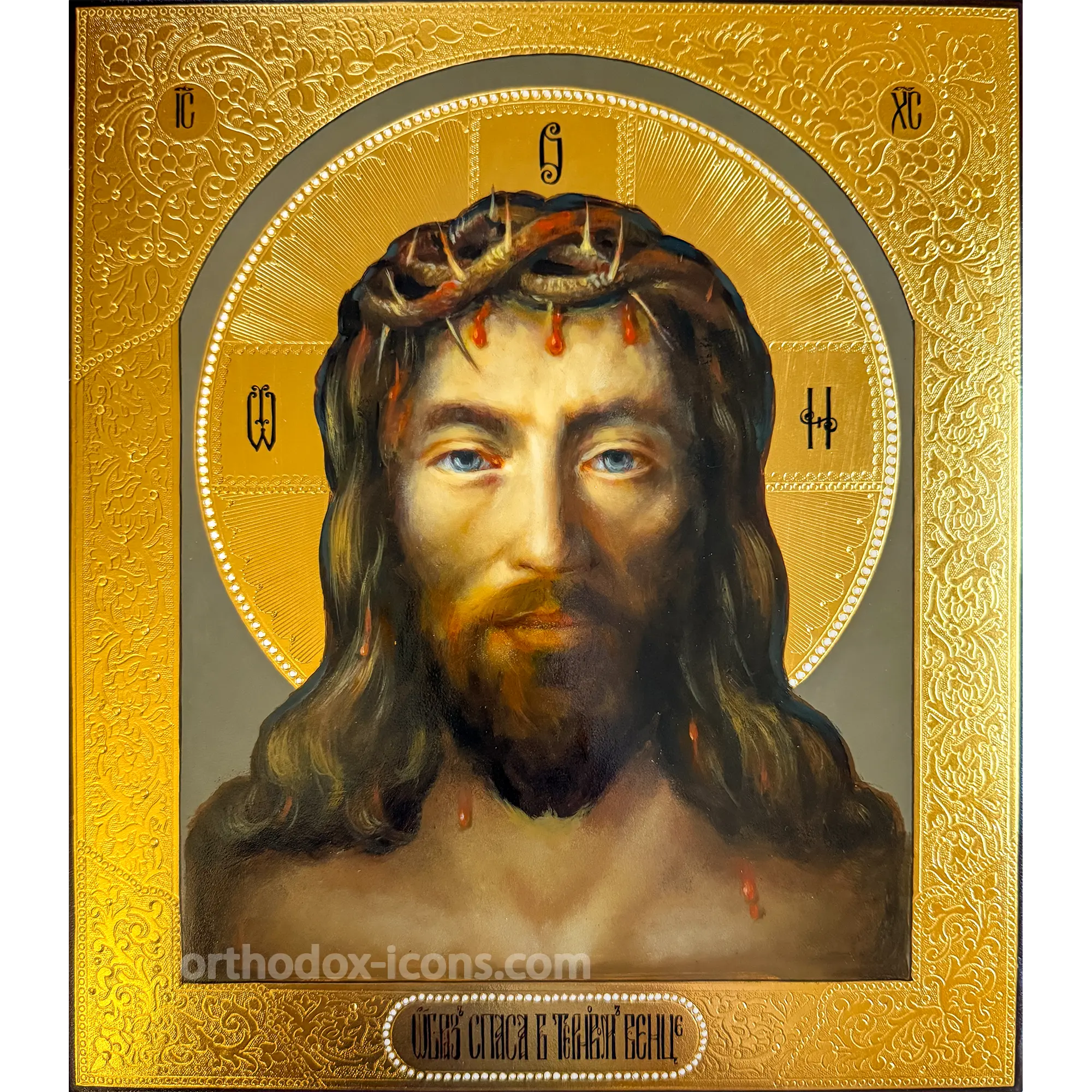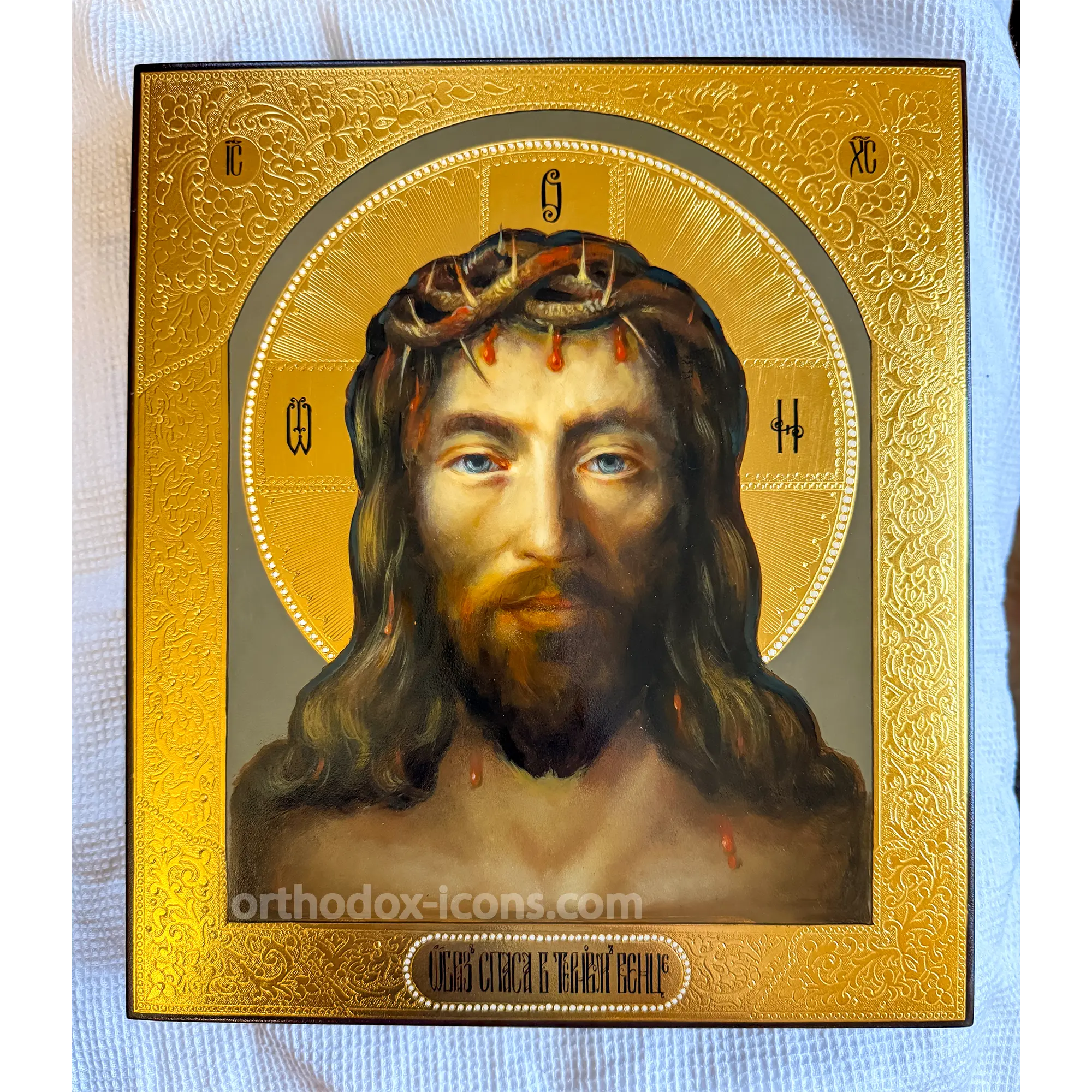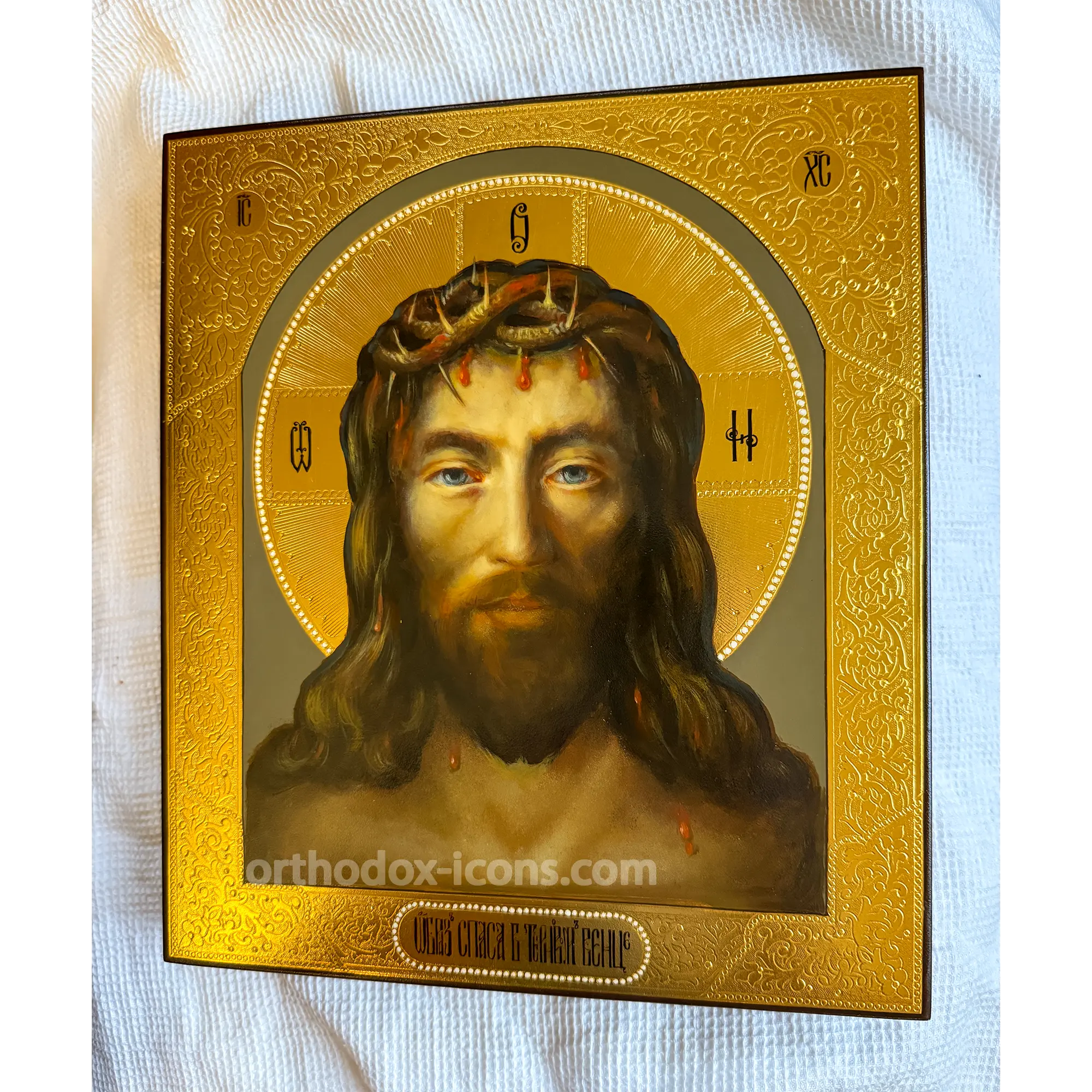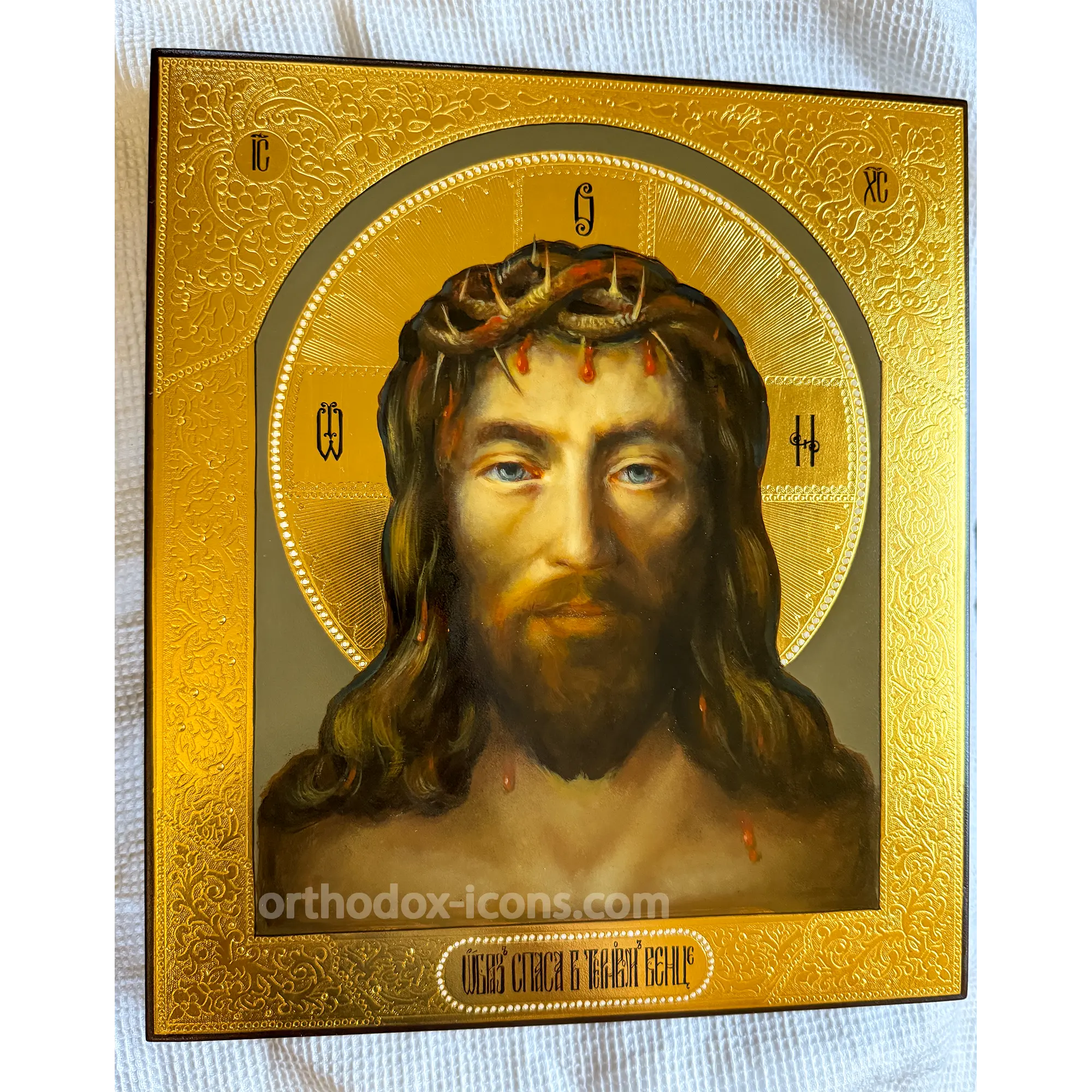Hand-Painted Icon of Christ in the Crown of Thorn
$1550
27х31cm (10.6×12.2 in)
The Hand-Painted Icon of Christ in the Crown of Thorn will be meticulously handcrafted for you at the Mstyora Icons Workshop, following the sacred traditions of Russian iconography.
-
Linden wood board with mortise-and-tenon joints for durability.
-
Natural materials: Pavoloka (linen), chalk levkas, 23K gold leaf (960 purity) by Manetti (Italy).
-
Egg tempera paints (handmade pigments on egg yolk).
-
Protective lacquer for longevity.
-
Hand-painted on wood by master iconographers.
-
Strict adherence to the Russian Orthodox canon.
-
Layered tempera application for luminous, enduring colors.
Each icon is a unique spiritual work of art, blessed by tradition and crafted with reverence.
It is possible to paint an image in any size to order
Available on backorder
Free shipping worldwide
Hand-Painted Christian Wall Art of Christ in the Crown of Thorns
A reverently created Hand-Painted Icon of Christ in the Crown of Thorns, executed with natural mineral pigments in egg tempera on a seasoned wooden panel, enhanced with genuine gold leaf and elaborate ornamental borders. This powerful sacred image depicts the Holy Face of Christ wearing the crown of thorns from His Passion, with drops of blood visible on His forehead, reflecting the profound suffering He endured for humanity’s salvation. The composition combines the miraculous tradition of the Holy Face (Spas Nerukotvorny) with explicit imagery of Christ’s torment, creating an icon of exceptional spiritual depth that invites meditation on the mystery of redemptive suffering and divine love.
Theological Meaning: The Crown of Thorns in Orthodox Tradition
The Icon of Christ in the Crown of Thorns (Спас в Терновом Венце), also known as “Christ the Bridegroom” or “Extreme Humility,” depicts one of the most poignant moments of Christ’s Passion—when Roman soldiers mocked Him by placing a crown woven from thorns upon His head, dressing Him in purple, and proclaiming Him “King of the Jews” in cruel jest. This event, described in all four Gospels (Matthew 27:27-31, Mark 15:16-20, Luke 23:11, John 19:2-3), represents the profound humiliation Christ accepted willingly as part of His redemptive sacrifice.
In Orthodox theology, this icon carries multiple layers of meaning. The crown of thorns paradoxically reveals Christ’s true kingship—not the worldly power the crowds expected, but the divine authority of One who conquers through self-emptying love. The thorns recall humanity’s fallen condition (Genesis 3:18 speaks of thorns as a consequence of sin), and Christ’s wearing them signifies His taking upon Himself the curse of sin. The blood that flows from the wounds represents the price of redemption, fulfilling prophecies of the Suffering Servant (Isaiah 53) and demonstrating the extent of God’s love for humanity.
Iconographic Features and Sacred Symbolism
This sacred composition presents Christ’s Holy Face with extraordinary detail and spiritual intensity, combining traditional iconographic elements with specific features related to the Passion narrative.
- The Crown of Thorns: Depicted with botanical accuracy, the interwoven thorns press into Christ’s sacred head, causing visible wounds. This crown transforms an instrument of mockery into a symbol of divine kingship won through suffering.
- Drops of Blood: Crimson droplets flow from the thorn wounds on Christ’s forehead and sometimes down His face, emphasizing the physical reality of His suffering and the precious blood shed for humanity’s salvation.
- Penetrating Gaze: Christ’s eyes meet the viewer directly with an expression combining profound sorrow with divine love and forgiveness, inviting personal encounter and repentance.
- Serene Countenance: Despite the visible suffering, Christ’s face maintains dignity and peace, reflecting His voluntary acceptance of the Passion and His victory over death even in the midst of torment.
- Golden Nimbus: The radiant halo surrounds the crowned head, proclaiming Christ’s divinity even in His most humiliated human moment, showing how divine glory shines through suffering.
- Elaborate Gold Borders: The ornate framework with intricate patterns creates a sacred space that separates this divine vision from ordinary reality while honoring the supreme sacrifice depicted.
Materials and Master Craftsmanship
This Hand-Painted Icon of Christ in the Crown of Thorns represents the pinnacle of iconographic artistry, requiring exceptional skill to convey both the physical realism of suffering and the spiritual luminosity characteristic of Orthodox sacred art.
- Seasoned Linden Wood: Premium wood prepared with linen backing and multiple layers of chalk gesso (levkas) to create the perfect foundation for this spiritually demanding composition.
- Genuine Gold Leaf: 23-karat gold leaf over bole, meticulously applied and tooled to create the radiant background and elaborate border ornamentation that frames Christ’s suffering.
- Natural Egg Tempera: Mineral pigments mixed with egg yolk, applied in successive layers to achieve the luminous flesh tones, the dark suffering of the crown, and the vivid red of Christ’s sacrificial blood.
- Detailed Thorn Rendering: Precise attention to the crown’s botanical structure and the wounds it creates, requiring both artistic skill and theological understanding to balance realism with iconographic dignity.
- Protective Varnish: Natural protective coating preserves the complex layering of colors and extensive gold work while maintaining the icon’s capacity to draw viewers into prayerful contemplation.
Spiritual Significance and Contemplative Power
The Icon of Christ in the Crown of Thorns invites believers into profound meditation on the mystery of redemptive suffering and divine love. This image is particularly powerful for those experiencing their own suffering, persecution, or humiliation, as it demonstrates that Christ has already entered into and sanctified human pain. The icon teaches that suffering, when united with Christ’s Passion, becomes redemptive and transformative rather than meaningless.
Many faithful report experiencing deep emotional and spiritual responses when praying before this icon—tears of repentance recognizing that Christ suffered for personal sins, gratitude for such incomprehensible love, and strength to bear their own crosses with patience. The image of the crowned Christ provides comfort in suffering by showing that God Himself experienced rejection, mockery, and physical torment, yet emerged victorious through resurrection.
Historical Development and Liturgical Use
While the Holy Face (Spas Nerukotvorny) tradition dates to early Christianity, the specific iconographic type showing Christ with the crown of thorns developed primarily in the late Byzantine period and became particularly prominent in Russian Orthodox iconography during the 17th-19th centuries. This development reflected increased emphasis on Christ’s humanity and the redemptive power of His suffering.
The icon is especially venerated during Holy Week, particularly on Holy Thursday and Friday when the Church commemorates Christ’s betrayal, trial, and crucifixion. It is often displayed on the analogion during the “Bridegroom Services” of Holy Week, where Christ is venerated as the Bridegroom who comes to meet His Bride, the Church, through His sacrifice.
Creating This Profound Icon: Artistic Process
- Spiritual Preparation: Deep meditation on the Passion narratives and patristic writings about Christ’s suffering to ensure theological accuracy and spiritual depth.
- Compositional Planning: Careful balance between depicting Christ’s suffering realistically and maintaining the dignity and luminosity required in Orthodox iconography.
- Crown Construction: Detailed work on the thorn crown, each thorn individually rendered to convey both botanical accuracy and symbolic weight.
- Facial Modeling: Subtle tempera layering to capture Christ’s expression—pain without despair, suffering without defeat, humanity revealing divinity.
- Blood Rendering: Precise application of red pigments to show the sacred blood as both physical reality and sacramental symbol of redemption.
- Gold Framework: Elaborate border work that honors the supreme sacrifice while creating a contemplative space for prayer and meditation.
Devotional Practice and Prayer Before This Icon
Orthodox Christians approach this icon with special reverence, particularly during Lent and Holy Week. Traditional prayers before the icon include petitions for forgiveness of sins (recognizing that Christ’s suffering was caused by human sinfulness), strength to bear personal crosses, healing from spiritual and physical afflictions, and deepening of love for Christ who suffered so willingly for humanity.
The icon serves as a powerful aid for the practice of kenosis—self-emptying love modeled on Christ’s own voluntary humiliation. By contemplating Christ’s acceptance of mockery, pain, and degradation, believers learn to surrender pride, accept humiliation without resentment, and find meaning in suffering when it cannot be avoided.
Contemporary Relevance for Suffering Believers
In an age when suffering is often seen as meaningless or something to be avoided at all costs, the Icon of Christ in the Crown of Thorns offers a radically different perspective. It shows that suffering, when accepted in union with Christ’s Passion, becomes redemptive and can lead to resurrection. This makes the icon particularly meaningful for those enduring chronic illness, persecution for faith, unjust treatment, or any form of humiliation.
Theological Themes: Kingship Through Suffering
The icon presents the paradox at the heart of Christianity—that true kingship comes through self-sacrificial love rather than domination, that glory is revealed in humiliation, and that victory comes through apparent defeat. The crown of thorns, meant as mockery, becomes the crown of true sovereignty, demonstrating that Christ’s kingdom operates by principles opposite to worldly power.
Placement and Veneration in Orthodox Settings
This icon deserves prominent placement where its profound message can be properly contemplated. In homes, it serves powerfully in prayer corners, especially during Lent and Holy Week. In churches, it is appropriate for Holy Week displays, Passion-themed chapels, or areas dedicated to prayers for the suffering and persecuted. The icon’s intense spiritual content makes it suitable for extended meditation rather than casual viewing.
Educational Value for Understanding the Passion
The icon provides an excellent opportunity for catechesis about Christ’s Passion, the theology of redemptive suffering, and the meaning of Christ’s kingship. It helps believers, especially children, understand that Christ’s suffering was real and voluntary, undertaken specifically out of love for each person who contemplates this sacred image.
Why This Hand-Painted Icon Transforms Spiritual Life
The presence of this Hand-Painted Icon of Christ in the Crown of Thorns creates a powerful focal point for contemplating the central mystery of Christian faith—that God became human to suffer and die for humanity’s salvation. The traditional materials and masterful execution ensure lasting beauty while providing daily inspiration for those seeking to understand and embrace the cross in their own lives.
Customization for Liturgical Applications
The Mstyora workshop can create this icon in various formats appropriate for different liturgical and devotional contexts. Options include variations in border ornamentation, coordinated sets for Holy Week displays, or adaptations for hospital chapels and places where suffering believers gather, all while maintaining the essential theological content and spiritual power of this profound image.
Care and Preservation Guidelines
- Environmental Protection: Keep away from direct sunlight to preserve the complex interplay of suffering and glory conveyed through careful color relationships.
- Reverential Handling: Given the icon’s intense spiritual content, approach with particular reverence during prayer and veneration.
- Gentle Cleaning: Use only soft brushes for dusting; avoid any substances that could damage the delicate rendering of blood and thorns.
- Long-term Preservation: The protective varnish maintains both the realistic suffering and spiritual luminosity with proper environmental conditions and care.
Welcome the transforming mystery of Christ’s redemptive suffering into your spiritual life—order this hand-painted icon from the Mstyora Workshop with free worldwide shipping by post and convenient payment by Visa/Mastercard upon delivery.
Questions and Answers
Q: What is the theological meaning of Christ wearing the crown of thorns?
A: The crown of thorns represents Christ taking upon Himself the curse of sin (thorns symbolize fallen creation), transforming an instrument of mockery into a symbol of true divine kingship won through self-sacrificial love.
Q: How does this icon differ from other Holy Face icons?
A: While most Holy Face icons show Christ in glory, this type explicitly depicts His Passion, including the crown of thorns and drops of blood, emphasizing His redemptive suffering and voluntary humiliation.
Q: When is this icon particularly venerated in Orthodox worship?
A: The icon receives special veneration during Holy Week, particularly during the “Bridegroom Services” on Holy Thursday and Friday when the Church commemorates Christ’s betrayal, trial, and crucifixion.
Q: Why does Christ maintain a serene expression despite the suffering depicted?
A: The peaceful countenance reflects Christ’s voluntary acceptance of the Passion and His divine victory over suffering and death, showing that His humiliation leads directly to resurrection and glory.
Q: What spiritual benefit comes from praying before this icon?
A: The icon invites meditation on redemptive suffering, provides comfort to those experiencing persecution or pain, inspires repentance by showing the cost of sin, and deepens love for Christ who suffered willingly for humanity.
Q: How can suffering believers connect with this icon?
A: The icon shows that Christ entered fully into human suffering, sanctifying it through His Passion. Believers can unite their own sufferings with His, finding meaning and redemptive power in what might otherwise seem senseless pain.
Q: What is the significance of the drops of blood shown on the icon?
A: The blood represents the precious price of redemption, fulfilling prophecies of the Suffering Servant and demonstrating the physical reality of Christ’s sacrifice. Each drop signifies divine love poured out for humanity’s salvation.
Q: Why does the icon combine realism of suffering with golden glory?
A: This paradoxical combination expresses Orthodox theology that Christ’s divinity shines through His humanity even at the moment of greatest humiliation, and that suffering leads directly to resurrection glory.
Q: What traditional materials and techniques are used in creating this icon?
A: The icon uses seasoned linden wood, genuine gold leaf, natural egg tempera pigments, and protective varnish, requiring master-level skill to balance realistic suffering with iconographic spiritual luminosity.
Q: How does this icon help believers understand Christ’s kingship?
A: The icon presents the Christian paradox that true kingship comes through self-sacrificial love rather than domination. The crown of thorns, meant as mockery, becomes the crown of sovereignty won through voluntary suffering for others.
| Dimensions | 27x31cm (10.6×12.2 in) |
|---|---|
| Name | Jesus |
Related products
The Resurrection of Christ Orthodox Icon
Available on backorder
$450 – $1400Price range: $450 through $1400Jesus Christ Orthodox Art
Available on backorder
$350 – $1300Price range: $350 through $1300Jesus Orthodox Icon
Available on backorder
$300 – $1400Price range: $300 through $1400


